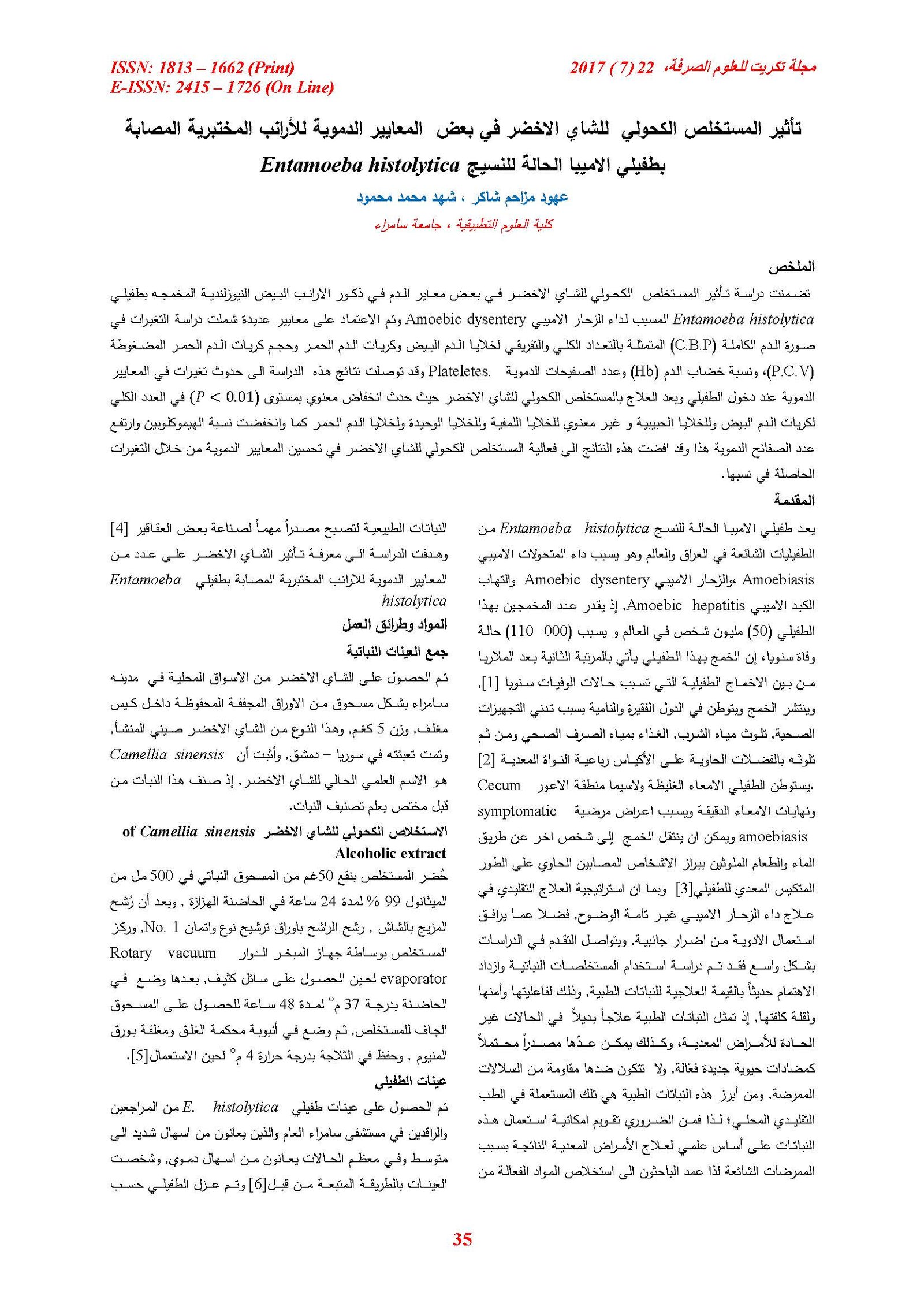Green Tea extrat Effect on number of blood Criteria of lab rabbits Afflicted whith Entamoeba histolytica parasite
Main Article Content
Abstract
The study includes the effect of alcoholic extract of green tea on the Newzealand white male rabbits putrefied by Entamoeba histolytica parasite which causes Amoebic dysentery disease. The study dependes on several criteria including the examination of variations in complete blood picture (C.B.P) presented by the whole and differential account of white and red blood cells, pressed red cells volume (P.C.V), hemoglobin (Hb) rate, and blood platelets number. The study concludes that variations in blood component occur when parasites enter and after the treatment with green tea alcoholic extract; where significant decrease result at level (P<0.01) in the total amount of white cells and granular cells and insignificant decrease in lymphatic cells, and single cells and red blood cells. hemoglobin rate also increased as well These results show the efficiency of green tea alcoholic extract in improving blood standards through variations occurring in blood proportion.
Article Details

This work is licensed under a Creative Commons Attribution 4.0 International License.
Tikrit Journal of Pure Science is licensed under the Creative Commons Attribution 4.0 International License, which allows users to copy, create extracts, abstracts, and new works from the article, alter and revise the article, and make commercial use of the article (including reuse and/or resale of the article by commercial entities), provided the user gives appropriate credit (with a link to the formal publication through the relevant DOI), provides a link to the license, indicates if changes were made, and the licensor is not represented as endorsing the use made of the work. The authors hold the copyright for their published work on the Tikrit J. Pure Sci. website, while Tikrit J. Pure Sci. is responsible for appreciate citation of their work, which is released under CC-BY-4.0, enabling the unrestricted use, distribution, and reproduction of an article in any medium, provided that the original work is properly cited.
References
1-Tachibana, H.; matsumoto, N.; Tsukamoto, H. and Yoshihara, E. (2004). Improved affinity of a human anti- E. histolytica GalGalNAc Lectin Fab fragment by a single amino acid modification of the light chain. Clin. Diagnostic Laboratory Immunology, 11(6):1085-1088.
2-DiMiceli, L. (2004). Distinguishing between pathogenic and non-pathogenic species of Entamoeba. Lab. Med., 35:613-616.
3- Fotedar, R.; Stark, D.; Beebe, N.; Marriott, D.; Ellis, J. and Harkness, J. (2007). Laboratory diagnostic techniques for Entamoeba species. Clin. Microbiol. Rev., 20(3): 511-532.
4- Fabricant, D. S.; Farnsworth, N. R. (2001). The Value of plants used in traditional medicine for drug discovery. Environ. Health Perspect. 109:69-75.
5- Swamy, S.M. (2000). Cytogenetic and Immunopotential effect of ethanolic extract of Nigella sativa seed .J. Ethanopharma 70(1):1-7.
6-Singh, A.; Ericttouft, B.H. and William, A.C. (2009). Rapid diagnosis of intestinal parasitic protozoa. J. Infect. Dis.,61(3): 280-286.
7- Clark, C. G and Diamond, L. S. (2002). Methods of Cultivation of huminal parasitic protists of Clinical importance. Clin. Microbiol. Rev., 15 (2): 329 – 341.
8-Roitt, I.; Brostoff, J. and Male, D. (1998). Immunology. 5th ed. Mosby International Ltd. UK .
9-Madigan, M.T.; Martinko, J.M. and Parker, J. (2003). Brook Biology of micro-organ. 10th ed., Williams & Wilkinsm London.
12-Richard, C. (2009). Immunology.6th ed. United states of America. 179-198
13- Marshall, A.;Thomas, J.; Kenneth, K. And Ernest, B. (2006). Williams Hematology.7th ed. United States of America.623-685
14-Havsteen B. (2002). The biochemistry and medical significance of the flavonoids. Pharmacology Ther. 96:67–202.
15- Russo A, Acquaviva R, Campisi A, Sorrenti V, Di Giacomo C, Virgata G. (2000). Bioflavonoids as antiradicals, antioxidants and DNA cleavage protectors. Cell Biol Toxicol. 16:91–8.
16-. Ackers, J. (2002). The diagnostic implication of separation of Entamoeba histolytica and Entamoeba dispar. Bio. Sci. 27(6):373-578.
17- Knupp, C.; Pekala, I. H. and Cornelius, P. (1988). Extrensive bone marrow necrosis in patients with cancer and tumor necrosis factor activity in plasma. Am. J. Hematol .,29:20-25.
